Have you ever thought about what it takes to be the best in chess? A 2900 rating is the top mark, showing you’re among the best. Magnus Carlsen, the current world champion, aims to hit 2900. He needs to boost his score by 35 points to get there.
Getting to a 2900 Elo rating is a huge achievement. It shows you’ve spent years honing your skills. Only a few players, like Magnus Carlsen and Garry Kasparov, have reached this level. It’s a rare feat, with only 0.01% of chess players worldwide reaching above 2700 Elo.
Table of Contents
Understanding Elo Ratings in Chess
If you play chess, you’ve probably heard of Elo ratings. They measure how strong a player is and rank them against others. The Elo system gives each player a rating based on their wins and losses in games. But, it’s not perfect and can lead to elo rating challenges that change a player’s score.
For example, the winner of a tournament might see their rating go down. This happens because the system has its own problems.
A player’s Elo rating can be anywhere from 400 to almost 3000. The higher the rating, the better the player is. Super grandmasters rating is usually around 2900. Chess player rankings vary a lot, depending on how well a player does.
Here are some general rating ranges to help you understand better:
- Beginner: 400
- Budding player: 1200
- Expert: 2000
- Chess Master: 2200
- Grandmaster: 2500
Knowing about the Elo rating system is key for serious chess players. It affects their chess player rankings and how well they do. By understanding the elo rating challenges and super grandmasters rating levels, players can do better in competitive chess.
The Highest Recorded Chess Rating in History
Exploring chess, you’ll see that a high rating is a big deal. Magnus Carlsen hit 2882 in May 2014, the highest ever. This shows the top of chess achievement, with only a few reaching it.
Before 2000, only six players hit 2700 or more. This shows how rare and special these ratings are.
Recently, top players have seen their ratings soar. This shows chess is getting more competitive. Magnus Carlsen leads with 2882, followed by Garry Kasparov and Fabiano Caruana. Levon Aronian also made it to the top list.
- 2882: Magnus Carlsen
- 2851: Garry Kasparov
- 2844: Fabiano Caruana
- 2830: Levon Aronian
These players have set amazing chess rating milestones. Their ratings show their skill and hard work. The highest rating is a big goal, and 26 players have reached 2750 to 2774.
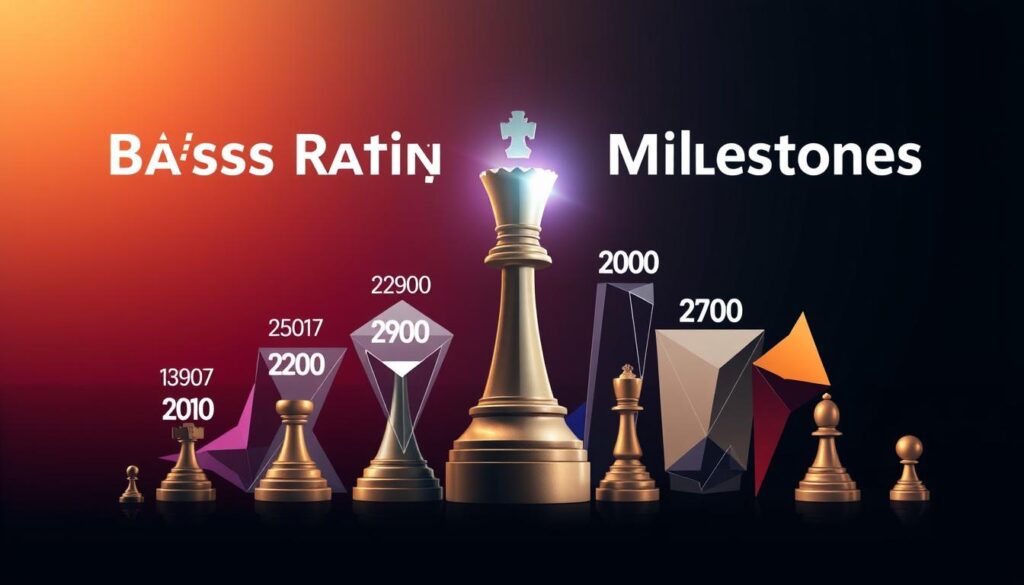
Current Top Chess Players and Their Ratings
In the world of chess, the top player rating shows a player’s skill. The top 10 players include Magnus Carlsen, Firouzja, Ding Liren, and Caruana. Carlsen is at the top, showing his skill and dedication.
Magnus Carlsen’s FIDE rating is 2831 as of January 2025. His highest rating was 2882 in May 2014. Hikaru Nakamura also has a high rating, reaching 2816 in October 2015.
Here is a list of the current top 5 chess players and their ratings:
- Magnus Carlsen – 2831
- Firouzja – 2804
- Ding Liren – 2799
- Caruana – 2792
- Nakamura – 2780
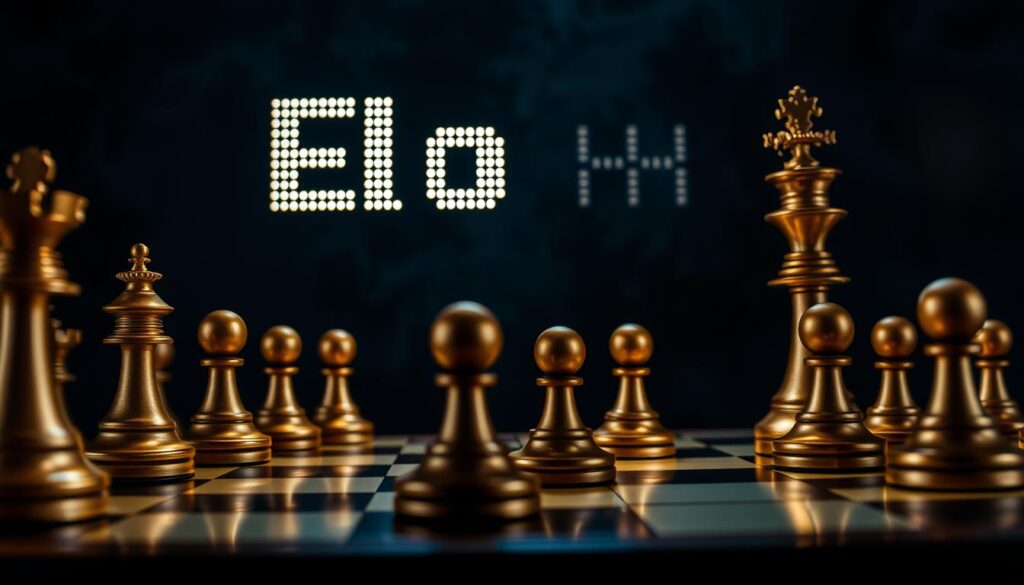
The chess player rankings change often. Players compete in tournaments to improve their ratings. The super grandmasters rating is a big goal for players. Watching the top players helps you understand the game’s skill level.
2900 Rating in Chess: What It Represents
Getting a 2900 rating in chess shows top-notch skill and a lot of hard work. It means you really understand the game and can think strategically. This level is seen as the top for chess players, with World Chess Champions usually around 2900.
In the chess world, a high level chess rating is hard to get. Only a few players make it to this level. To get a 2900 rating, you must win against strong opponents often. For instance, beating someone 300 points higher can boost your rating by about 60 points. But, winning against someone of the same rating only adds about 30 points.
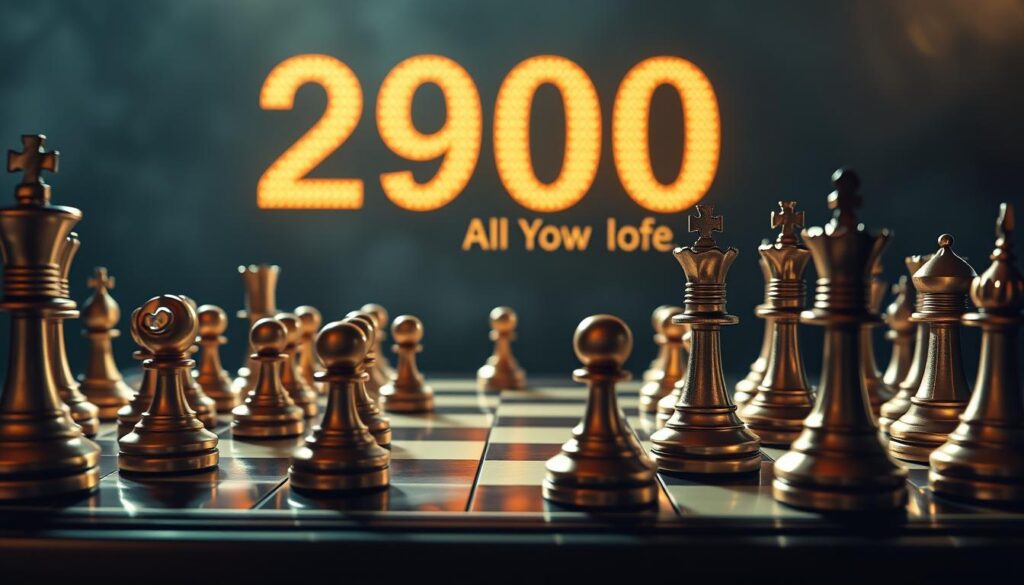
Some chess players have reached great heights, like GM Avetik aiming for 2900 on chess.com in 2020. The journey to a 2900 rating is tough, with many hurdles. Yet, for those who love chess, the hard work is worth it.
To understand this achievement better, here are some skill levels based on ratings:
- 400: Beginner
- 800: Basic understanding of the game
- 1200: Developing chess player
- 1600: Top scholastic players
- 2000: Expert Level
- 2200: National Master
- 2400: Senior Master
- 2500: Grandmaster
- 2900: World Chess Champion level
Reaching a 2900 rating in chess is a huge achievement. It shows a player’s skill, strategy, and hard work. It’s the highest goal in chess.
Challenges in Reaching a 2900 Elo Rating
Getting to a 2900 Elo rating is very hard. It needs a deep understanding of chess and great strategic thinking. You face many elo rating challenges, like rating drops in some wins. Even top players like Magnus Carlsen are still short of 2900.
The super grandmasters rating is rare, with only a few reaching over 2800. The chess player rankings are super competitive. But, the Elo system has a flaw that can lower the winner’s rating. This makes reaching 2900 even harder.
Some key stats show how tough it is to hit 2900 Elo:
- Only 0.1% of all rated players have surpassed an Elo rating of 2700.
- The average rating of top-tier chess players is between 2600 and 2700.
- To reach 2900, you need to win about 97% of games against top players.
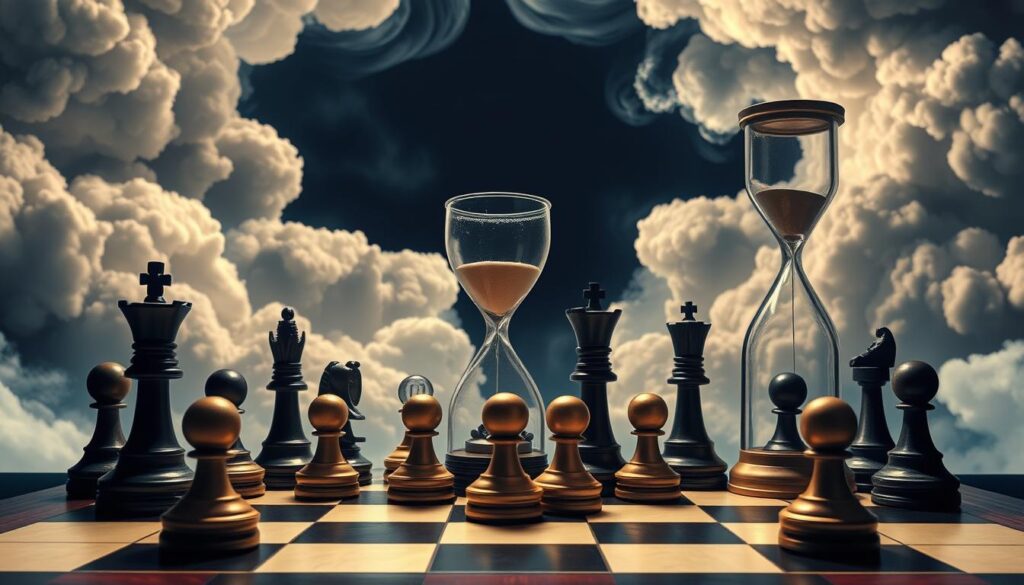
The journey to 2900 Elo is long and tough. It takes at least 20 years of intense practice and competition. Keeping a rating over 2900 for a long time is very unlikely. Even the best players see their ratings change a lot.
| Player | Elo Rating |
|---|---|
| Magnus Carlsen | 2863.92 |
| Firouzja | 2804.03 |
| Ding Liren | 2799.04 |
Why is 2900 Elo so Difficult to Reach in Chess?
Getting to a 2900 Elo rating in chess is very hard. This is because top players keep getting stronger and technology helps them a lot. The highest recorded chess rating in history shows how skilled the best players are. To grasp why a 2900 Elo rating is hard to get, we need to understand how Elo ratings work in competitive chess.
The Elo rating system was created in the 1960s. It’s used to measure how good a player is. But, it has its flaws. It counts wins, draws, and losses to figure out ratings. A win is 1 point, a draw is 0.5 points, and a loss is 0 points. It’s hard to win against weaker players, making it tough to get points.
Several factors make it hard to reach a 2900 Elo rating. These include:
- Chess players are getting stronger, making it harder to beat them.
- Technology, like chess engines and analysis tools, helps players improve.
- Winning against weaker players is expected, making it hard to get points.
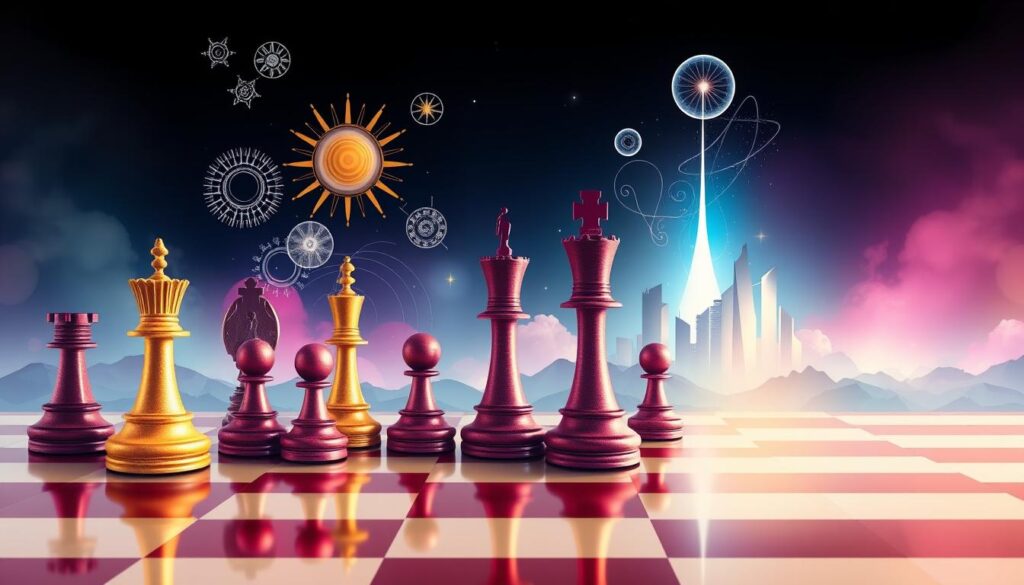
These challenges show that getting to a 2900 Elo rating is a huge achievement. It requires a deep understanding of why is 2900 elo so difficult to reach in chess? and being very good at the game.
Magnus Carlsen’s Journey Towards 2900
Magnus Carlsen is the world’s top chess player. He aims for a 2900 Elo rating. This goal is a big challenge, but he’s determined to reach it.
Carlsen’s journey shows why achieving a 2900 Elo rating is so hard. His dedication and hard work make him a great example.
Some of Carlsen’s achievements include:
- Winning 15 world championship titles, the most in history
- Defeating GM Ian Nepomniachtchi in the 2021 FIDE World Championship match
- Achieving an Elo rating close to 2900, showing the goal is not just the number
Thinking about why is 2900 elo so difficult to reach in chess? Look at Carlsen’s journey and the hurdles he’s faced. His goal to reach a 2900 Elo rating inspires many in chess.
Carlsen’s story teaches us that greatness comes from hard work and determination. As you explore chess and the goal of a 2900 Elo rating, remember only a few, like Magnus Carlsen, can achieve it.
| Player | Elo Rating | World Championship Titles |
|---|---|---|
| Magnus Carlsen | 2882 | 15 |
| GM Ian Nepomniachtchi | 2793 | 0 |
The Role of Technology in Increasing Ratings
Improving your chess skills means understanding how technology helps. Computers and chess engines have changed the game. They let players analyze games and get better.
With technology, players can access lots of chess data. This includes games and strategies to improve their play.
In competitive chess, how elo ratings work is key. Elo ratings measure player skill levels. The chess player rankings are based on these ratings, which change with each game. Technology helps track these ratings accurately, helping players see where they need to get better.
Some stats show how technology affects chess:
- Stockfish 14, a chess program, has a rating of 3534, much higher than Magnus Carlsen’s 2856.
- The gap between Stockfish 14 and Carlsen is 678 points, showing a big skill difference.
- Technology also helps catch cheaters online. Hans Niemann admitted to cheating in 2 games and was reported for over 100.
In summary, technology is crucial for improving chess ratings. It offers access to lots of data, accurate Elo ratings, and cheating detection. As you work on your skills, knowing how technology helps will be key to your success.
| Player | Elo Rating |
|---|---|
| Magnus Carlsen | 2856 |
| Stockfish 14 | 3534 |
What Would It Take to Achieve a 2900 Chess Rating?
To get a 2900 chess rating, you need to understand chess deeply and think strategically. It’s not just about winning games. It’s about consistently playing well against strong opponents. High level chess rating means you must analyze complex situations and make precise moves.
Some important things to work on for a 2900 rating include:
- Developing a strong opening repertoire
- Improving endgame skills
- Enhancing analytical skills
- Managing time effectively during games
Magnus Carlsen, for example, has an Elo rating of 2863.92. To hit 2900, he needs to gain 36.08 rating points. This shows how hard it is to reach a high chess rating, even for the best players.
To get a 2900 rating, you must beat 75% of players rated 2700+ consistently. This takes a lot of practice, dedication, and perseverance. What would it take to achieve a 2900 chess rating? It’s a question many chess fans ask. The answer is hard work, strategic thinking, and a deep love for chess.
Global Perception of a 2900 Elo Rating
A 2900 Elo rating is seen as the top achievement in chess. It’s a chess grandmaster rating that many players dream of. Reaching this level shows great skill, strategy, and hard work.
In the chess world, a 2900 Elo rating is a sign of excellence. Only a few players have reached this level. As of August 2022, Magnus Carlsen’s Elo rating is 2860, still short of 2900.
Here are some stats that show how hard it is to get a 2900 Elo rating:
- The second-ranked player, Ding Liren, has an Elo rating of 2806, which is 54 points lower than Carlsen’s.
- Carlsen’s rating has stayed very stable over the last two years, showing his consistency.
- The K-factor for Grandmaster (GM) chess play is set at K=10, the lowest in the FIDE system.
To get a 2900 Elo rating, a player needs to know chess very well and handle pressure well. The global perception of a 2900 Elo rating is that it shows a player’s skill, strategy, and mental strength. As chess keeps evolving, many players aim for this chess rating milestone.
| Player | Elo Rating | Ranking |
|---|---|---|
| Magnus Carlsen | 2860 | 1 |
| Ding Liren | 2806 | 2 |
The Future of Chess Ratings
As you think about chess, you might wonder about its rating system’s future. The Elo rating system is the main way to measure chess players’ skills. But, it might face challenges ahead. New rating systems could change how players are ranked.
Super grandmasters, the best chess players, are key to the future of ratings. They have ratings over 2800. Yet, they face big challenges in the Elo system. It might need to change to handle their exceptional skills.
Changes to the Elo system could include better algorithms or more factors. For example, how a player does in different games. These updates could make the system more accurate and fair for everyone.
Here is a comparison of different rating systems:
| Rating System | Description | Advantages |
|---|---|---|
| Elo | Traditional rating system | Simple, widely used |
| Sticko | Alternative rating system | More accurate, adaptable |
| Glicko | Another alternative rating system | More precise, robust |
In conclusion, the future of chess ratings is uncertain. But, the Elo system will likely remain important. As chess evolves, the rating system will too. It will adapt to meet the needs of players and the game.
Conclusion
Reaching a 2900 Elo rating in chess is a huge challenge. It needs dedication, strategic skills, and a deep understanding of the game. Your journey to chess mastery is full of lessons and growth opportunities.
By learning about the Elo rating system and studying top players like Magnus Carlsen, you can find your own path to greatness. Whether you aim for the 2900 mark or just want to get better, focus on improving your tactics, learning new openings, and understanding positional play.
Keep pushing your chess skills to new heights. Remember, the real joy of chess isn’t just about the rating. It’s about the strategic battle, the thrill of beating your opponent, and the pride of every win. Enjoy the journey, face the challenges, and let your love for chess lead you to success.
FAQ
Is it possible to achieve a 2900 Elo rating in chess?
Getting a 2900 Elo rating in chess is very hard and prestigious. The Elo rating system is used to measure a player’s skill. A 2900 rating shows a player is very skilled and dedicated.
How do Elo ratings work in competitive chess?
Elo ratings are key in competitive chess. They help rank players based on their performance. But, the system has some flaws, like reducing the winner’s rating in some cases.
What is the highest recorded chess rating in history?
The highest chess rating ever recorded is a big achievement. This section will talk about the players who reached this milestone. It will also explain why this achievement is so important.
Who are the current top chess players and what are their ratings?
Today’s top chess players are very talented and dedicated. Many have reached very high ratings. This section will look at the current top players and their ratings. It will also talk about the significance of these ratings in chess.
What does a 2900 Elo rating represent in chess?
A 2900 rating in chess shows a player is very skilled and dedicated. It requires a deep understanding of the game and strategic thinking. This section will explore what a 2900 rating means, including its significance and the challenges it brings.
What are the challenges in reaching a 2900 Elo rating?
Reaching a 2900 Elo rating is very challenging. It requires a deep understanding of chess and strategic thinking. The Elo system also has challenges, like reducing the winner’s rating in some cases. This section will discuss the challenges of reaching a 2900 Elo rating, including the flaws in the Elo system and the impact of technology.
Why is 2900 Elo so difficult to reach in chess?
Achieving a 2900 Elo rating is hard for several reasons. The strength of chess players is increasing, and technology is playing a big role. This section will explain why reaching a 2900 Elo rating is so hard, including the impact of technology and the Elo system.
What has Magnus Carlsen’s journey towards a 2900 Elo rating been like?
Magnus Carlsen’s journey to a 2900 Elo rating is interesting. It has had its challenges and setbacks. This section will look at Magnus Carlsen’s journey, including the challenges he faced and the strategies he used.
How has technology impacted the game of chess and ratings?
Technology has changed chess a lot. It helps players analyze games and improve their skills. This section will talk about how technology has increased ratings, including the role of computers and chess engines.
What would it take to achieve a 2900 chess rating?
To get a 2900 chess rating, you need skills and strategy. You need to understand the game deeply and think strategically. This section will look at what it takes to achieve a 2900 chess rating, including the necessary skills and strategy.
How is a 2900 Elo rating perceived globally?
A 2900 Elo rating is seen as a big achievement in chess. It represents the highest level of skill and dedication. This section will discuss how a 2900 Elo rating is viewed globally, including its significance in the chess community and its impact on the game.
What is the future of chess ratings?
The future of chess ratings is uncertain. There could be changes to the Elo system and the impact of technology. This section will discuss the future of chess ratings, including potential changes to the Elo system and their impact on the game.
















